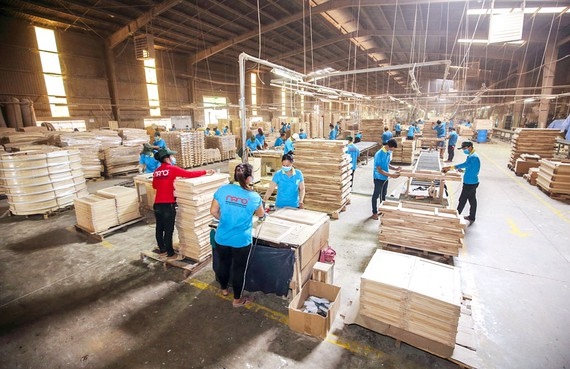Russia-Ukraine war impacts wood industry
Russia-Ukraine war impacts wood industry
Vietnam's wood processing and export enterprises are currently facing new difficulties and challenges because of the ongoing Russia-Ukraine conflict.
Illustrative photo. |
Indirect supply line
Russia and Ukraine are not major partners for the export and import of wood products from Vietnam. In 2021, Vietnam's wood imports from Russia only reached around USD 55 mn, a very small volume equivalent to 2% of the total import turnover of Vietnam's wood materials from all sources. The export of wood and wood products from Vietnam to the Russian market are even more modest. In 2021, the export turnover of Vietnam's wood and wood products to Russia only reached about USD 7.3 mn, equivalent to 0.05% of the total export turnover of Vietnam's wood and furniture items to the world market. Exports and imports of Vietnam's wood to Ukraine are also very modest.
Although the wood export market is low, there is concern about the negative impact of the Russia-Ukraine conflict on domestic wood enterprises. The first is in the supply of raw materials. Although Vietnam is not a country that directly imports a lot of wood materials from Russia, it is not small in importing raw materials indirectly through the intermediary markets. Currently, China is the largest market for importing wood materials from Russia, with imports to China accounting for around 50% of Russia's total annual exports of logs and sawn timber. After importing from Russia, Chinese wood enterprises then process and export to other markets, including Vietnam.
For many years, wood originating from Russia has been imported to Vietnam through China, mainly in the form of lumber and veneer products, accounting for a large proportion of the total amount of imported wood materials. On an average, each year Vietnam imports over 70,000 cubic meters of sawn timber and nearly 200,000 cubic meters of veneer from China, including birch, yellow maple, oak, and pine, originating from Russia. In 2021, veneer from birch wood imported into Vietnam reached more than 120,000 cubic meters, accounting for 89% of the total amount of veneer imported into Vietnam in that year. Vietnam's wood industry depends on input materials from China and Russia so much that there have been warnings about dire consequences.
According to Mr. Do Xuan Lap, Chairman of the Vietnam Timber and Forest Products Association, China is currently one of the three most important markets for Vietnam's wood industry, along with the US and EU, in terms of both supply and demand. On an average each year, the bilateral trade turnover of Vietnam and China in wood products reaches about USD 2 bn, with the trade balance in favor of Vietnam. However, the size of the surplus is gradually shrinking, when the export turnover of Vietnam's wood products to the Chinese market shows signs of declining or even a slight decrease from 2020 to now, while the import turnover of wood products into Vietnam from this market is increasing very strongly. However, most of the raw materials for the wood industry that Vietnamese enterprises import from China come from Russia.
Supply shortage
Russia is one country with an extremely large area under natural forests, about 815 mn hectares, nearly 60 times larger than the current forest area of Vietnam. Russia's annual logging volume is about 200 mn cubic meters, equivalent to 10% of the global supply. Every year, Russia exports about 15 mn cubic meters of logs, accounting for 12% of the global volume of logs. Russia is also the largest supplier of sawn timber in the world and ranks 7th in export turnover of wood products. In 2021, Russia's export turnover of wood and wood products reached about USD 12.3 bn, which mainly were wood materials. Russia also exports over 30 mn tons of logs and sawn timber every year.
The Russia-Ukraine conflict may shrink the supply of wood materials from Russia, creating a shortage of wood materials on a global scale in the future. In the short term, part of this shortfall can be offset by an increase in existing supplies from the EU and the US, which have similar timber species as Russia. However, the shortage in supply can create competition between countries importing raw wood, including Vietnam. Vietnam depends on imported raw materials, to the tune of five to six mn cubic meters of logs per year.
According to Dr. To Xuan Phuc, an expert at Forest Trends Vietnam, in the furniture export market of Vietnam, Russia is a very small market. However, Vietnam is a big wood furniture exporter, but depends a lot on imported raw materials. Therefore, the wood industry trade between Vietnam and Russia is tilted towards importing wood materials from China. If the Russia-Ukraine conflict lasts longer, the wood supply from Russia, with an annual supply of nearly 40 million tons of raw materials, will be lost. There is a shortage in the supply of raw wood while the consumer demand for wood products continues to increase, pushing up the price of raw wood materials, creating fierce competition for all raw materials.
The current Russia-Ukraine conflict has led to a negative impact on the domestic wood enterprises as the price of input materials has begun to increase. It is possible that Vietnamese enterprises will have to compete more fiercely with businesses from other countries for imported wood materials, especially in the important wood supply markets for Vietnam such as the EU and the US. In addition, the price of imported wood materials has increased, reducing the competitive advantage of domestic enterprises in the international arena. Shortage of supply from Russia may also create a new demand for many timber species to be replaced in the future.





















